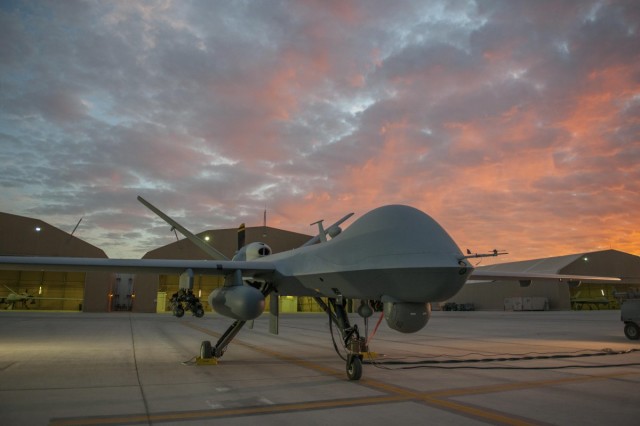The MQ-9 extended-range Reaper debuted in combat over Afghanistan, launching from Kandahar Airfield earlier this month, officials announced. For the 62nd Expeditionary Reconnaissance Squadron at Kandahar Airfield, Afghanistan, efforts to increase those capabilities are in full swing after completing an extended range modification to nearly half of their fleet of MQ-9 Reapers and flying the first ever ER sortie in Afghanistan, Dec. 1, 2015.
The Reaper, a remotely piloted aircraft primarily designed for intelligence, surveillance and reconnaissance collection, can also perform close air support, combat search and rescue, precision strike and other critical functions, making it an indispensable tool.
Supporting one of the largest Reaper squadrons in the Air Force, maintainers at the 62nd ERS had a large task of completing the ER modification while the squadron continued to provide world-class close air support and intelligence, surveillance and reconnaissance in the Afghanistan area of responsibility.
“All of our ER aircraft out here were boxed up, shipped out [from the U.S.], and between us and our General Atomics partners, we performed all the mods here in the AOR,” said Capt. Garrik, 62nd ERS maintenance operations officer. “One of the things that at our level we are really proud of here is that we did it on top of completing our regular flying schedule.”
The depot-level modification to their fleet took a mere month.
Now that the majority of the mods are complete, the 62nd ERS will increase their flight length capability by 20-to-40 percent depending upon the MQ-9’s loadout.
“ER gives us more time in the air, so pilots are able to stay on a certain area of interest for much longer,” said Capt. Mike, 62nd ERS aircraft and maintenance officer-in-charge. “Instead of having to come back, land and try to get another airplane out there, it allows the airplane to stay airborne longer.”
Although the reaper is primarily used as an intelligence-collection asset and secondarily against dynamic execution targets, it can also play a guardian angel role in the AOR.
According to Mike, the squadron utilized the MQ-9 to find a U.S. vehicle that got separated from a convoy and lost in enemy territory. Normally stopping for rest in a situation like that would have been catastrophic even after being awake for more than 18 hours. Instead the 62nd was able to communicate down and tell them to stop.
“We had aerial coverage of everything around them, locked, loaded and ready to go,” said Mike. “They were able to pull off on the side of the road and sleep knowing that the 62nd was over them. Not only do we go out and hunt for the bad guys, we’re out there when our troops are and playing guardian angel for them all the time.”
Although the amount combat air patrols has significantly decreased in Afghanistan, the impact of the 62nd ERS remains vital.
“We don’t have as many CAPs as we did 5 or 10 years ago, but we are at sustainable point right now are looking to increase CAPs here,” said Mike. “We’re still going to fly the same amount, but they will just be up for a longer duration. More airplanes in the sky at any point in time mean more eyes on target.”
Photo: An MQ-9 Reaper equipped with an extended range modification from the 62nd Expeditionary Reconnaissance Squadron sits on the ramp at Kandahar Airfield, Afghanistan, Dec. 6, 2015. – U.S. Air Force photo by Tech. Sgt. Robert Cloys/Released
Source: US Air Force

